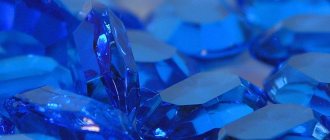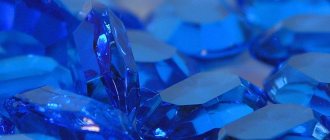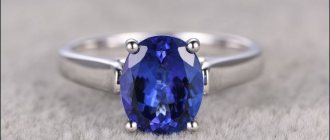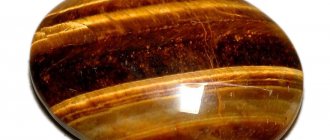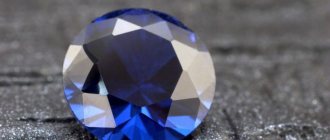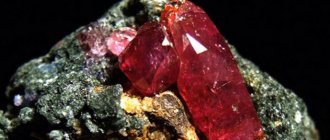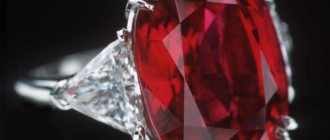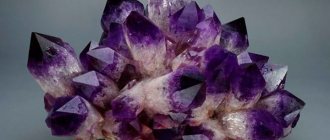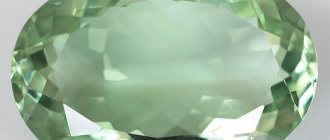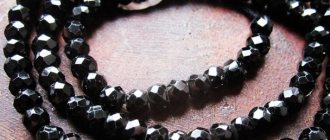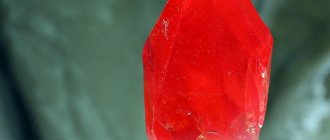What is the difference between ruby and sapphire? In fact, both stones are varieties of the same mineral. Red corundum is called ruby. It contains chromium, which is responsible for the “bloody” color of the gem. Blue corundum is sapphire. Titanium and iron add blueness to it. If there are few impurities, the shade is weak; if there are many, the stone gets a rich color.
Both varieties are classified as precious stones and have high strength - 9 points on the Mohs scale
Their other properties are, for the most part, the same.
Physical and chemical properties of ruby
Ruby minerals are mined on all continents except Antarctica. There are many deposits, the largest are located in Myanmar, Thailand and Sri Lanka. The main component of the composition is aluminum. Formula – Al2O3. Rubies are not characterized by cleavage; they have a clearly visible glass luster.
Transparency may vary depending on the presence of inclusions, chips and other defects. The purest stones, which are almost completely transparent, are used in jewelry. The gem is notable for its high refractive index, which varies between 1.766-1.774 in different samples.
The color of rubies can be rich – bright scarlet, burgundy, red-violet. There are also more delicate pink shades.
According to the degree of quality, minerals are divided into three groups:
- the first - completely clean stones or transparent specimens with small point defects;
- the second - samples with larger, but still small inclusions, which are grouped in separate zones and form a defect visible to the eye;
- the third is numerous cracks, stripes and inclusions of foreign substances, due to which the light transmittance of the stone is significantly reduced.
In 1904, scientist Auguste Verneuil learned to create rubies in the laboratory. The synthetic analogue is identical in composition to the natural one, but its production is cheaper
Artificial rubies are used to make luxury watches and jewelry, and they are also used in quantum electronics.
My Yakhontovy: ancient names of stones
Each of us read Russian folk tales as a child. And ever since then, somewhere deep in our souls, unusual and even “magical” names of stones have remained. Folklore, ancient Russian literature, dialects and famous classics have left in our memory ancient yachts, emeralds, golden sparks...
Now we will tell you an ancient jewelry story.
Majestic diamond
The most durable and fascinating stone, shrouded in the mystery of its origin, was diamond. Transparent crystals were found near bodies of water, washed out along with gold, found in the mountains... But these were only random finds. No matter who tried to find him, it ended in disappointment. Only towards the end of the 19th century it became clear that diamonds are formed not in rivers, but deep underground.
Today we know it as one of the most expensive and sought-after precious stones - diamond.
Azure and scarlet yachts
Since ancient times, yachts in Rus' were considered the most beautiful stones. These gems were also loved by many poets and writers.
They sigh about love only furtively,
Yes, the eyes are burning like yachts.
(S.A. Yesenin)
How did they conquer the hearts of our ancestors?
It turns out that the currently known sapphires used to be called azure yachts, and rubies and garnets were called scarlet yachts. It is not surprising that their rich color and bright shine captivated nobles, skilled jewelers and ordinary people.
Noble Smaragd
“Wear this ring with emerald constantly, beloved, because emerald is the favorite stone of Solomon, the king of Israel. He is green, pure, cheerful and tender, like spring grass, and when you look at him for a long time, your heart brightens; if you look at it in the morning, the whole day will be easy for you.” (A.I. Kuprin “Sulamith”)
Another ancient name for the gemstone is emerald. This green and transparent crystal has been known for a long time. And now it is known as emerald.
Sea treasures
A long time ago, strange sea stones appeared in Rus' from the southern lands. The name of Burmitz grain has its roots in an ancient city on the shores of the Persian Gulf. It was there that they once began to extract pearls and send them to Russian lands.
In addition to pearls, they also brought a bright red kingstone from the sea shores. And as you might guess, in the old days coral was called a king.
Multi-colored planers
Planers used to be called semi-precious stones that could be easily shaped, that is, “planed.” Strugantsi are all varieties of quartz. These included: amethyst - dumpling, rock crystal - flint savage, onyx - nogat, agate - babogur, and also aventurine - golden spark.
Now we are accustomed to seeing modern names of jewelry minerals, but in the times of Ancient Rus', ancient names of jewelry caused people no less delight. Agree, there is something incredibly melodic and full of deep meaning in this. Zlatoiskr - sparkling with gold...
Sky colored stones
The rich hues of the clear sky and sea water were mesmerizing, as were the kalaig (aka firuze) and tumpaz. The mysterious name kalaig (or firuze) originated in Turkish, and now we call this stone turquoise.
As you might guess, the ancient Slavs called sky-blue topazes tumpaz.
Sunny Alatyr
“On the sea, on the ocean, on the island of Buyan, lies the white-flammable stone Alatyr, the father of all stones.”
In ancient times, the Alatyr stone was endowed with special properties and treated with great respect. Previously, people believed that this stone worked miracles, was able to heal diseases and even ward off death. They believed that it was a divine stone. Alatyr was found, as a rule, on the shores of the Baltic Sea, and therefore was named in consonance with the Baltic dialects. Apparently, due to its specific properties, the name of the solar mineral also echoes the word “altar”. Be that as it may, now we know this stone as a noble jewelry insert and call it amber.
Jewelry has such a huge heritage that no one can exhaust its possibilities. Time passes, but values remain. The names change, but the beauty remains unchanged. Likewise, the ancient names of stones come to life in new reinterpretations, giving rise to new meanings and inspiring designers to create truly fabulous jewelry.
Properties of sapphire
In the jewelry industry, sapphire means corundum of any color except shades of red. In a broad sense, this is a blue analogue of ruby. However, the color diversity of the mineral is not limited to cold shades. Gems of yellow, orange and green colors are found in nature. Some of them are completely transparent and have the highest jewelry quality.
The chemical formula of the mineral is the same as that of ruby. Other characteristics are also the same:
- density;
- hardness;
- refractive index.
Sapphire is also endowed with a beautiful natural shine and plays intricately with colors after cutting. Taking into account the almost complete identity of the composition, the fact that ruby is more expensive than its blue counterpart or sapphire of other colors is of some interest. This is explained by the fact that red minerals are less common in natural deposits.
The melting point of corundum and both of its subspecies is 2050 °C.
Artificial ruby
In the gemstone market, it is customary to “ennoble” rubies. Impurities are removed from the mineral, thus making it more transparent, and defects (cracks and voids) are filled with glass. An artificial analogue of a gem becomes more attractive in appearance and inexpensive compared to a natural one. Another way is to grow the mineral artificially. Only a specialist can distinguish artificial from natural minerals.
Also, scammers can use a less expensive one that is similar in appearance as a gemstone. Usually these are garnet and ruby. For technical purposes, artificial ruby is widely used, since it has the property of not entering into chemical reactions. For example, in dentistry - as a material for implantation and prosthetics.
Varieties of ruby and sapphire
Each type of corundum has its own classification. Red stones of the ruby group are divided into:
- Burmese - a rare subspecies that is present in only one deposit - in Myanmar (formerly Burma);
- star-shaped - stones, during the cutting process of which the effect of asterism is revealed.
The most unique variety of ruby is called “Pigeon Blood”. It is a transparent mineral of red-violet color, which is least common in natural deposits.
Sapphires are most often classified by color, but there are also gemological varieties:
- star-shaped - gems with the visual effect of the shine of a six-pointed star;
- cat's eye - a white light stripe shines on the surface;
- trapice is the rarest variety, creating a unique optical illusion that combines both previous effects.
Ruby and sapphire differ in price. The minimum cost of scarlet corundum is $100 per carat. It is clear that for that kind of money you can only buy low-quality samples that do not reach the level of jewelry. A carat of sapphire with similar defects will cost the buyer approximately $60.
Ruby crystal for zodiac signs
Astrologers recommend wearing rubies to Aries, Leo and Sagittarius. You can wear the mineral with caution for Virgos and Taurus. They almost categorically insist on the danger of the gem for Cancers and Scorpios. Some modern astrologers believe that for Cancers this stone is suitable for strengthening love, as well as showing determination in achieving their goals. For Sagittarius, the mineral helps smooth out negative traits and solve important life problems. According to the horoscope, representatives of Libra, Aquarius and Cancer should be very careful when using the mineral as a talisman or amulet. If they are overly sensitive, they may not be able to cope with the energy of the stone.
How to distinguish a ruby from a fake
Both synthetic and other stones are similar to natural ruby: spinel, garnet, tourmaline. Most often, scammers can sell garnets under the guise of a ruby. A large natural ruby is a very rare phenomenon and its cost will be very high. By the obvious discrepancy between price and size, one can distinguish between synthetic and natural stone. How to distinguish a natural ruby? It can be distinguished from pyrope, a type of garnet that is most often passed off as a ruby, by its dichroism property. This phenomenon can be seen using a dichroscope (a special magnifying glass through which color changes from dark to light can be seen in layers). Dichroism is characteristic only of rubies.
Property of dichroism
Unfortunately, it is not possible to distinguish natural from artificial at home; this can only be done by a specialist using special tools.
Price
The cost of a stone is determined by four indicators, which in English-speaking countries are called the four C rule (Colour, Clarity, Cut, Carat weight):
- sapphire color;
- purity of the stone;
- cutting;
- carat weight.
- These characteristics of sapphire together determine its value. The most important of them is color as a decisive indicator of the quality and possibility of using a stone in jewelry.
Now these stones, so beloved by royalty, occupy a worthy place in the catalogs of the largest jewelry houses. Regardless of whether the jewelry uses a classic or innovative combination of metals and stones, sapphires will emphasize the refined taste and style of their owner.
Characteristics
Now all corundums are called sapphires, with the exception of those that are red in color (rubies). From a chemical point of view, the description of the stone is as follows: sapphire is a mineral consisting almost entirely of aluminum oxide. It has a glassy luster and one of the highest strength values on the Mohs scale (the table indicates a number of 9 points). Only diamond is considered a harder mineral. The clarity and purity of sapphire can vary. There are both transparent stones, varying in purity, and completely opaque gems.
Some corundums are characterized by the phenomenon of asterism - the appearance on the surface of a stone of a star with six or twelve rays. This feature occurs in minerals with rutile inclusions, using a cutting method called “cabochon”. Star sapphires are more expensive than others.
Production
Sapphire is a stone whose deposits are found on all continents except Antarctica. The most valuable and beautiful of them are considered to be minerals native to India and Tanzania. The island of Ceylon is also a popular place where sapphire is mined. In India, the Kashmir deposit was discovered after an earthquake, which exposed rich deposits of sapphires of amazingly pure, cornflower blue color. This shade is considered the reference shade for blue corundums. Ceylon stone and gems from Burma are approaching him. Now the development of the Kashmir field has been stopped.
In Tanzania, two types of stones are mined, which have received a separate name. Songea and Tunduru are the names of the deposits, which also became the names of the sapphires mined there. Songea are often green or reddish stones, among which there are many minerals with the effect of asterism. It is believed that these corundums have the richest color palette. An interesting feature of songea is its amazing purity, combined with its small size. Songea measuring 2 carats is already a rarity. Tunduru is the only deposit in Tanzania where blue minerals are mined.
Stones from the island of Ceylon (Sri Lanka) are known not only for their quality, but also for their rare properties. Minerals are often mined there that can exhibit asterism after a suitable cut or change color under certain conditions. They often become exhibits in collections in their own right, without being included in a piece of jewelry.
Ceylon is also a place where sapphires, which have a unique pink-orange color, are mined. They are called padparadscha. There is a version that this color of the stone and its name come from the word meaning lotus color. The islanders who first discovered pink sapphires described their color as a cross between a light and delicate lotus petal and a rich Ceylon sunset. Padparadscha, like Tanzanian songeas, rarely reach large sizes. Padparadscha, weighing more than 5 carats, is already a collectible, and the largest of them weighs just over 100 carats and is located in the New York Historical Museum.
Of course, it is impossible to tell everything about sapphires at once, because their history goes back centuries, and each deposit has its own unique history. This means that people who have a serious interest in jewelry will always discover new real stories and legends associated with this gem.
Main varieties of corundum
Corundum is a type of mineral stone that is distinguished by its high hardness and a variety of colors. Due to these properties, it is used in jewelry.
The color of a stone depends on its chemical composition:
- Blue, also known as sapphire, contains titanium, vanadium and iron oxide.
- Red (ruby) - chrome, titanium, iron.
- Colorless (leucosapphire) - does not contain impurities, therefore it is most often used in industry.
Some varieties of sapphire have a green tint. They are less attractive than emeralds, so they are cheaper.

